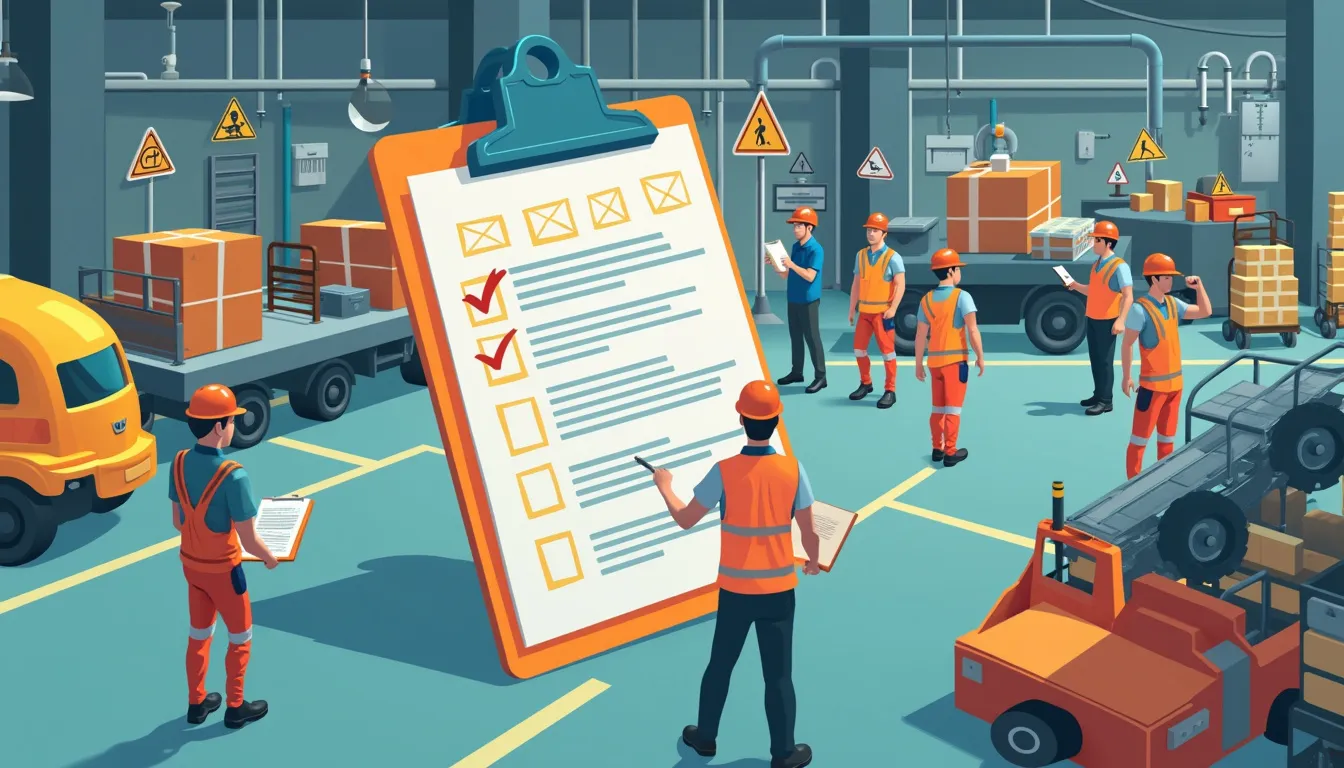In today’s fast-paced business environment, ensuring a safe workplace is paramount. A thorough workplace risk assessment serves as the cornerstone for mitigating potential hazards and safeguarding employees. Understanding the importance of this process can significantly reduce accidents, ensure compliance with regulations, and enhance overall productivity. This article delves into effective strategies for conducting workplace risk assessments, providing an overview of identifying potential hazards, assessing and prioritizing risks, and implementing preventive measures. By adopting these strategies, organizations can foster a culture of safety, reduce liability, and promote employee well-being, ultimately translating to a more prosperous and efficient operation. Read on to discover how you can create a safer working environment through strategic risk management practices.
Importance of Workplace Risk Assessment
Every successful business understands the critical nature of ensuring a safe and secure working environment. A robust workplace risk assessment is not merely a regulatory requirement but a crucial practice that safeguards your most valuable asset: your employees. Conducted meticulously, a risk assessment helps to identify potential hazards that could lead to injuries, illnesses, or even fatalities. It is the bedrock for fostering a culture of safety and ensures that operations continue without interruptions from unforeseen incidents.
Overview of Key Strategies
Implementing effective strategies for workplace risk assessment is akin to fortifying the foundation of a building. It involves a methodical approach encompassing the identification of potential hazards, assessing and prioritizing risks, and establishing preventive measures. By employing techniques such as regular audits, employee training, and using advanced assessment tools, organizations can mitigate risks efficiently. It’s about proactive management and staying a step ahead of potential dangers.
Benefits of Implementing Effective Risk Assessments
Investing in comprehensive workplace risk assessments yields invaluable returns. Firstly, it ensures compliance with occupational safety and health regulations, thus avoiding hefty fines and legal repercussions. Secondly, it fosters an environment where employees feel valued and protected, which translates to higher job satisfaction and productivity. Furthermore, a well-executed risk assessment can lead to reduced workplace accidents, minimizing downtime and associated costs. In essence, it’s a strategic investment towards enhancing operational efficacy and securing long-term success.
Safetyology – Get The Book Today!

Identifying Potential Hazards
When undertaking a workplace risk assessment, the primary goal is to identify potential hazards that could compromise employee safety and disrupt operations. This step is foundational, ensuring you’re equipped to mitigate risks effectively. Understanding common types of workplace hazards, techniques for identifying these risks, and the best tools and resources for hazard detection is vital.
Common Types of Workplace Hazards
Workplace hazards come in various forms, each presenting unique challenges and necessitating tailored strategies. Generally, these hazards can be categorized as:
- Physical Hazards: These include anything that can cause physical harm, such as machinery, noise, and trip hazards.
- Chemical Hazards: Exposure to harmful substances like cleaning agents, industrial chemicals, and vapors falls under this category.
- Biological Hazards: This involves exposure to harmful biological agents, including bacteria, viruses, and molds.
- Ergonomic Hazards: Poor workstation design, repetitive motions, and improper lifting techniques can lead to musculoskeletal disorders.
- Psychosocial Hazards: Stress, workplace harassment, and bullying are examples of risks that can impact mental health.
Techniques for Identifying Risks
Identifying potential hazards requires a systematic approach that incorporates various techniques to ensure a comprehensive understanding of workplace risks. Here are a few effective methods:
- Workplace Inspections: Regular inspections can help uncover hazards before they pose serious threats. A checklist based on industry standards can guide these inspections.
- Task Analysis: Evaluating how tasks are performed enables you to identify risks tied to specific activities. This involves scrutinizing each step of a task to detect potential hazards.
- Employee Feedback: Your employees are on the front line and often have insights into hazards that may not be immediately apparent. Encourage open communication and feedback mechanisms.
- Incident Investigation: Analyzing previous incidents and near-misses provides insight into existing hazards and highlights areas needing improvement.
- Job Safety Analysis (JSA): This detailed examination of job tasks and their hazards ensures safer operational standards and practices.
Tools and Resources for Hazard Detection
Leveraging the right tools and resources is instrumental in accurately detecting workplace hazards. Here are some essential ones:
- Safety Audits: Conducting comprehensive safety audits with standardized tools can identify non-compliance and hazard areas.
- Risk Assessment Software: Modern technology offers sophisticated software that helps track, assess, and prioritize risks. These tools streamline data collection, making risk management more efficient.
- Sensors and Monitoring Devices: Utilize sensors to monitor environmental conditions like air quality, noise levels, and equipment performance. This real-time data helps in proactive hazard detection.
- Industry Databases: Resources such as OSHA’s database provide valuable data on industry-specific hazards, regulatory guidelines, and best practices.
- Checklists and Templates: Predefined checklists and templates can standardize and simplify the risk identification process, ensuring no potential hazard is overlooked.
Identifying potential hazards is a critical component of the workplace risk assessment process. By being thorough and employing robust techniques and tools, you fortify your organization’s ability to safeguard its workforce and maintain operational continuity. Ensure your risk assessment strategy incorporates these elements to create a safer working environment.
Safetyology – Get The Book Today!

Assessing and Prioritizing Risks
Once potential hazards are identified, the next crucial step in workplace risk assessment is to assess and prioritize these risks. Effective prioritization ensures that the most critical risks are addressed promptly, mitigating their impact on overall workplace safety.
Methods for Risk Assessment
The foundation of any robust risk assessment lies in selecting the right methods. Various techniques, such as qualitative and quantitative assessments, offer insightful perspectives on potential dangers. A qualitative approach involves the compilation of expert opinions and historical data, while quantitative assessments rely on statistical and numerical analysis. Each method has its strengths; combining them can provide a comprehensive understanding, balancing subjective insights with objective data.
The Hazard Identification and Risk Assessment (HIRA) technique is commonly employed in workplace risk assessments. This method systematically evaluates the likelihood and severity of identified hazards. It involves brainstorming sessions, checklists, and consultations with employees to capture a wide array of potential risks. Employing HIRA ensures a thorough examination of all conceivable hazards, ensuring nothing slips through the cracks.
Criteria for Risk Prioritization
Prioritizing risks involves a critical analysis of their potential impact and the probability of occurrence. The severity of a risk is determined by its potential to cause harm, which might range from minor injuries to severe fatalities or significant financial losses. The frequency with which a risk could potentially occur also influences prioritization, as highly frequent but less severe risks might require more immediate attention than rare catastrophic events.
Data-driven criteria, including past incident reports, industry benchmarks, and safety standards, guide this process. Engaging with all levels of the workforce to gather anecdotal insights also enriches the risk prioritization matrix. When employees feel their experiences and observations are valued, they are more likely to contribute valuable information that can unearth overlooked hazards.
Utilizing Risk Matrices and Assessment Software
Risk matrices are valuable tools for visualizing and categorizing risks based on their severity and likelihood. A typical 5×5 matrix, for instance, rates risks from ‘insignificant’ to ‘catastrophic’ on one axis and from ‘rare’ to ‘almost certain’ on the other. This visual partitioning helps organizations easily identify which risks should be tackled first. For instance, a risk rated as ‘catastrophic’ with a ‘likely’ chance of occurrence demands immediate action, while a ‘moderate’ risk that’s ‘unlikely’ might be addressed later.
In an era of digital transformation, assessment software amplifies the efficiency and accuracy of workplace risk assessments. Tools like BowtieXP, RAMs Manager, and RiskWatch integrate data collection, analysis, and visualization, simplifying the entire assessment process. These digital tools provide real-time updates, predictive analytics, and automated reporting, ensuring that no stone is left unturned in the hunt for potential risks.
Moreover, these software solutions often feature dashboards that allow for real-time monitoring of identified risks, tracking mitigation progress, and compliance with safety protocols. By utilizing these tools, organizations can transition from reactive to proactive risk management, staying ahead of potential hazards and fostering a safer work environment.
In conclusion, assessing and prioritizing risks is an indispensable part of a workplace risk assessment. By employing a blend of qualitative and quantitative methods, setting clear prioritization criteria, and leveraging advanced digital tools, organizations can effectively safeguard their workforce and operations. These strategies not only comply with regulatory requirements but also demonstrate a commitment to creating a safe and resilient workplace.
Safetyology – Get The Book Today!

Implementing Preventive Measures
Now that you’ve identified and assessed potential hazards in your workplace, the next critical step in your workplace risk assessment process is to implement preventive measures. This involves developing comprehensive safety protocols, initiating effective employee training and awareness programs, and setting up systems for continuous monitoring and improvement. Each measure plays a pivotal role in safeguarding the health and well-being of employees while minimizing business risks.
Developing Safety Protocols
Creating robust safety protocols is essential for mitigating identified risks. Begin by documenting all identified hazards and the corresponding preventive actions. This should be detailed and easily accessible to all employees. Clearly define safe work procedures, emergency response plans, and compliance measures tailored to your specific industry and organizational needs.
Standard Operating Procedures (SOPs) should be developed for high-risk tasks to ensure consistency and adherence to safety standards. Regularly update these protocols to accommodate changes in operational processes, technology, and regulatory requirements. Engaging employees in the development process can enhance the effectiveness of these protocols as it increases buy-in and ensures practical applicability.
Employee Training and Awareness Programs
No matter how comprehensive your safety protocols are, their effectiveness hinges on employee understanding and adherence. Therefore, the cornerstone of a successful workplace risk assessment implementation is providing thorough and ongoing employee training and awareness programs.
Start with conducting initial training sessions that introduce employees to newly developed safety protocols, explain the importance of risk assessments, and educate them on how to identify and report hazards. Use a blend of training methods such as workshops, e-learning modules, and hands-on demonstrations to cater to different learning styles.
Furthermore, make safety an integral part of your corporate culture by incorporating it into regular staff meetings, newsletters, and performance appraisals. Encourage open communication, where employees feel comfortable sharing safety concerns and suggestions. This participative approach not only boosts compliance but also fosters a proactive safety culture.
Continuous Monitoring and Improvement
The implementation of preventive measures does not end with training and protocols. Continuous monitoring and iterative improvement are vital to maintaining a safe work environment. Establish a system for regular inspections and audits to ensure compliance with safety standards and identify any emerging risks.
Deploy technology solutions such as sensor-based monitoring systems and risk management software to streamline the monitoring process. These tools can provide real-time data and analytics, enabling more accurate and prompt decision-making.
Additionally, encourage feedback from employees on the effectiveness of the safety measures in place. Conduct regular review meetings and update your risk assessment plans accordingly. Continuous improvement should be embedded in your organizational philosophy to adapt to evolving workplace dynamics and ensure sustained safety performance.
By focusing on the strategic implementation of these preventive measures, you are not only complying with legal requirements but also demonstrating a commitment to fostering a safe and healthy work environment. Remember, effective workplace risk assessment is an ongoing journey of improvement and vigilance, paving the way for a resilient and productive workplace.
Conducting a thorough workplace risk assessment is not merely a regulatory requirement; it’s a cornerstone of a safe and productive work environment. By emphasizing the identification, assessment, and mitigation of potential hazards, businesses can protect their most valuable assets—their employees—and foster a culture of safety. Employing a multifaceted approach to hazard detection using various tools and resources ensures nothing is overlooked. Prioritizing these risks appropriately, through the use of well-defined criteria and advanced assessment software, enables organizations to allocate resources efficiently and address the most pressing dangers first.
Implementing preventive measures is where theory meets practice. Developing robust safety protocols tailored to the unique demands of each workplace, combined with comprehensive employee training, ensures everyone is well-prepared to maintain a safe workspace. Continuous monitoring and adaptive improvement mean that risk assessment isn’t a one-time task but a dynamic, ongoing process. In this way, effective workplace risk assessment strategies do more than prevent accidents—they lay the groundwork for an empowered, vigilant workforce ready to meet any challenge safely and efficiently.
Safetyology – Get The Book Today!
Support Us: Check out our recommended products on Amazon.

